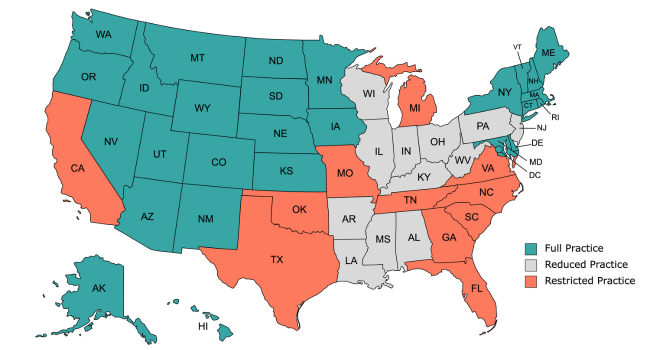
As the healthcare landscape continues to evolve, so too does the role of nurse practitioners (NPs) within the system. One significant aspect that defines the scope of practice for NPs is the level of autonomy granted to them, or the practice environment. Practice environments are often classified into three categories: Restricted Practice Authority, Reduced Practice Authority, and Full Practice Authority.
In this post, we explore the nuances of each practice environment, shedding light on the pros and cons that nurse practitioners may encounter within each framework.
For a quick look at state practice environments across the country, see the map below.

Restricted Practice Authority
Restricted Practice Authority refers to the most limited scope of practice for nurse practitioners. In this model, NPs are typically required to work under the direct supervision of a physician, with specific restrictions on their ability to diagnose and treat patients autonomously. The intention behind Restricted Practice Authority is often rooted in concerns about patient safety and the desire to ensure that nurse practitioners, while highly skilled, work within a more controlled environment.
Pros of Restricted Practice Authority
Enhanced Supervision and Mentorship: NPs working under restricted practice benefit from direct supervision, allowing for continuous mentorship and support from experienced physicians. This can be particularly valuable for early-career nurse practitioners seeking guidance as they build their clinical expertise.
Collaborative Team Approach: Restricted practice environments promote a collaborative healthcare team, where NPs work closely with physicians and other healthcare professionals. This collaborative approach can lead to comprehensive patient care and improved communication among team members.
Cons of Restricted Practice Authority
Limited Autonomy: The most significant drawback is the restricted autonomy, limiting the NP’s ability to make independent clinical decisions. This can potentially hinder the nurse practitioner’s professional growth and efficacy in providing timely care.
Dependency on Physician Availability: The need for constant physician supervision can result in delays in patient care, especially if the supervising physician is not readily available. This can impact the efficiency of healthcare delivery.
Reduced Practice Authority
In a Reduced Practice Authority setting, nurse practitioners have a bit more independence compared to the restricted model but still operate with certain constraints. While they may not require constant supervision, they may face limitations on specific aspects of patient care, such as prescribing certain medications or performing certain procedures independently.
Pros of Reduced Practice Authority
Increased Autonomy: NPs under reduced practice authority enjoy more autonomy compared to their counterparts in restricted environments. This allows them to take a more active role in patient care, making decisions independently within the defined scope of practice.
Flexibility in Collaborative Practices: The reduced level of supervision fosters a more flexible collaborative practice environment. NPs can work more autonomously while still having access to consultation and collaboration with physicians when needed.
Cons of Reduced Practice Authority
Prescriptive Limitations: Depending on state regulations, nurse practitioners in reduced practice environments may face restrictions on their ability to prescribe certain medications, hindering their ability to provide comprehensive care independently.
Potential for Fragmented Care: While the collaboration is encouraged, the potential for fragmented care exists, especially if there are unclear communication channels between NPs and other healthcare team members. This could lead to gaps in patient care and outcomes.
Full Practice Authority
Full Practice Authority represents the highest level of autonomy for nurse practitioners. In this model, NPs have the ability to practice to the full extent of their education and training without the need for physician oversight or collaboration. This approach recognizes the advanced skills and expertise of nurse practitioners, empowering them to serve as primary care providers.
Pros of Full Practice Authority
Complete Autonomy: The primary advantage of full practice authority is the complete autonomy it affords nurse practitioners. They can diagnose, treat, and manage patient care independently, contributing to improved efficiency and timely healthcare delivery.
Increased Access to Care: Full practice authority helps address the shortage of primary care providers in various regions by allowing nurse practitioners to practice without the need for physician supervision. This can enhance access to healthcare services, especially in underserved or rural areas.
Cons of Full Practice Authority
Potential for Increased Liability: With greater autonomy comes increased responsibility, and nurse practitioners practicing with full authority may face higher liability risks. It is crucial for NPs to have a thorough understanding of legal and ethical considerations to mitigate potential legal challenges.
Resistance and Opposition: Despite the proven competence of nurse practitioners, some healthcare professionals and organizations may resist the idea of full practice authority. Overcoming these barriers may require advocacy efforts and a cultural shift within the healthcare system.
Conclusion
The practice environment for nurse practitioners is diverse and continually evolving, with Restricted Practice Authority, Reduced Practice Authority, and Full Practice Authority representing distinct models that influence the scope of practice. Each model has its own set of pros and cons, and the choice between them is often influenced by state regulations, healthcare system dynamics, and professional preferences.
While some may value the structured mentorship and collaboration provided by restricted practice, others may seek the freedom and responsibility that come with full practice authority. Regardless of the chosen path, ongoing dialogue, collaboration, and advocacy within the healthcare community are essential to advancing the role of nurse practitioners and ensuring optimal patient care.
Seamlessly Navigate Compliance and Regulations with Zivian Health
As nurse practitioners navigate their careers, understanding the implications of each practice environment is crucial. Zivian’s mission is to simplify and streamline compliant collaborations to empower NPs and expand access to health care.
We help nurse practitioners connect with physicians within their specialty in a secure online collaboration software. We’ll match you with a collaborating physician in a matter of days. Plus, you’ll have access to our easy-to-use platform to track all of your state requirements, including meetings, chart reviews, and licensure.
Get started with Zivian today by contacting us here.